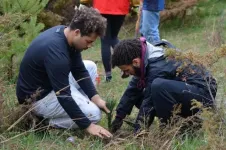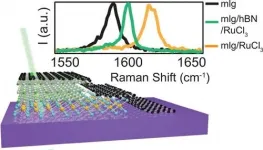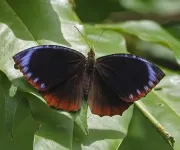(Press-News.org) The reproductive cycle of viruses requires self-assembly, maturation of virus particles and, after infection, the release of genetic material into a host cell. New physics-based technologies allow scientists to study the dynamics of this cycle and may eventually lead to new treatments. In his role as physical virologist, Wouter Roos, a physicist at the University of Groningen, together with two longtime colleagues, has written a review article on these new technologies, which was published in Nature Reviews Physics on 12 January.
'Physics has been used for a long time to study viruses,' says Roos. 'The laws of physics govern important events in their reproductive cycle.' Recent advances in physics-based techniques have made it possible to study self-assembly and other steps in the reproductive cycle of single virus particles and at sub-second time resolution. 'These new technologies allow us to see the dynamics of viruses,' Roos adds.
Energy
In 2010, he first published a review article on the physics aspects of virology with two of his colleagues. 'Back then, almost all of the research on viruses was relatively static, for example exerting pressure on a virus particle to see how it responded.' At that time, studies on dynamic processes, such as self-assembly, were performed in bulk, without the option to zoom in on individual particles. 'This has changed over the last couple of years and therefore, we thought it was time for another review.' This paper, 'Physics of Viral Dynamics', was co-authored by Robijn Bruinsma from the University of California in Los Angeles (USA) and Gijs Wuite from VU Amsterdam (the Netherlands).
Viruses hijack cells and force them to make the protein building blocks for new virus particles and to copy their genetic material (either RNA or DNA). This results in a cellular soup full of virus parts, which self-assemble to produce particles of encapsulated RNA or DNA. 'No external energy is required for this process. And even in vitro, most viruses will self-assemble quickly.' This process was traditionally studied in bulk material, averaging out the behaviour of large numbers of virus particles. 'So, we had no idea of the variance in the assembly of individual particles.'
Sub-second scans
Over the last few years, technologies have been developed to study these individual particles in real-time. One of those is fast Atomic Force Microscopy (AFM). An atomic force microscope scans surfaces with an atom-sized tip and is therefore able to map their topology. 'Recently, the scanning speed of AFM increased dramatically and now we can carry out sub-second scans of surfaces that measure less than 1 micrometre squared using High-Speed AFM,' says Roos, who uses an AFM himself. 'This allows us to see how virus subunits assemble on a surface. It is a very dynamic process, with building blocks attaching and releasing.'
Single-molecule fluorescence is also used to study viruses, for example, the attachment of viral proteins to DNA. 'Using optical tweezers, we hold two tiny beads on either end of a DNA molecule. When viral proteins bind to the DNA, this will coil up and bring the two beads closer together. This is visualized by fluorescent markers attached to the beads.' Alternatively, proteins with fluorescent markers can be observed while they attach to viral DNA or to other proteins. A third technology is to use an optical microscope to measure interference of light that is scattered by virus particles. These patterns reveal the structure of the particles during assembly.
Toughen up
Other steps in the virus cycle can also be studied. 'After they have self-assembled, particles need to toughen up to withstand conditions outside the host cell,' says Roos. Other modifications also occur, which prepare the particles to infect other cells. The dynamics of this maturation process are important for our understanding of how viruses work. 'And after infecting new cells, the virus particle has to come apart to release its genetic material.'
New technology is now revealing the physical dynamics of viruses. It allows scientists such as Roos and his colleagues to study how genetic material is incorporated and which physical principles guide this process. Most antiviral drugs disrupt the first steps in infection, such as the binding of virus particles to their host cells. Using this new dynamic information, we could develop drugs that block self-assembly or other important steps in the reproductive cycle of the virus.
Nanotechnology
Insight into the physics of virus particles is also important for their use in research, for example as building blocks in nanotechnology or as carriers for antigens in vaccines. Several of the leading COVID-19 vaccines use adenoviruses to deliver the gene for the SARS-CoV-2 spike protein to cells, which then express this gene and consequently generate an immune response. 'Understanding how the adenovirus comes together and falls apart could help to create more stable vaccines.'
Simple Science Summary
Viruses are very small particles and it is therefore difficult to study them directly. They are also very dynamic; for example, virus particles self-assemble inside infected cells. In recent years, technical improvements have made it possible to study the dynamics of single virus particles and see what exactly happens during their reproductive cycle. These results can help scientists to develop drugs that disrupt the self-assembly or other important steps in the virus cycle. Furthermore, they may help to stabilize viruses that are used to produce vaccines, such as the adenovirus-based coronavirus vaccines. A review of the different techniques to study viral dynamics has now been published in the journal Nature Reviews Physics by University of Groningen physicist Willem Roos and two of his colleagues.
INFORMATION:
Reference: Robijn F. Bruinsma, Gijs J. L. Wuite and Wouter H. Roos: Physics of viral dynamics. Nature Reviews Physics 12 January 2021.
In the inaugural issue of the journal Nature Aging a research team led by aging expert Linda P. Fried, MD, MPH, dean of Columbia University Mailman School of Public Health, synthesizes converging evidence that the aging-related pathophysiology underpinning the clinical presentation of phenotypic frailty (termed as "physical frailty" here) is a state of lower functioning due to severe dysregulation of the complex dynamics in our bodies that maintains health and resilience. When severity passes a threshold, the clinical syndrome and its phenotype are diagnosable. This paper summarizes the evidence meeting criteria for physical frailty as a product of complex system dysregulation. ...
Astronomers have curated the most complete list of nearby brown dwarfs to date thanks to discoveries made by thousands of volunteers participating in the Backyard Worlds citizen science project. The list and 3D map of 525 brown dwarfs -- including 38 reported for the first time -- incorporate observations from a host of astronomical instruments including several NOIRLab facilities. The results confirm that the Sun's neighborhood appears surprisingly diverse relative to other parts of the Milky Way Galaxy.
Mapping out our own small pocket of the Universe is a time-honored quest within astronomy, and ...
NEW YORK (January 14) -- A new study co-authored by researchers from the Wildlife Conservation Society's (WCS) Global Conservation Program and the University of British Columbia (UBC) Faculty of Forestry introduces a classification called Resistance-Resilience-Transformation (RRT) that enables the assessment of whether and to what extent a management shift toward transformative action is occurring in conservation. The team applied this classification to 104 climate adaptation projects funded by the WCS Climate Adaptation Fund over the past decade and found differential responses toward transformation ...
A wide breadth of behaviors surrounding oral sex may affect the risk of oral HPV infection and of a virus-associated head and neck cancer that can be spread through this route, a new study led by researchers at the Johns Hopkins Kimmel Cancer Center suggests. These findings add nuance to the connection between oral sex and oropharyngeal cancer -- tumors that occur in the mouth and throat -- and could help inform research and public health efforts aimed at preventing this disease.
The findings were reported Jan. 11 in the journal Cancer.
In the early 1980s, researchers realized that nearly all cervical cancer is caused by the human papillomavirus (HPV), a DNA virus from the Papillomaviridae family. Although about 90% of HPV infections ...
The higher a person's income, the more likely they were to protect themselves at the early stages of the Covid-19 pandemic in the United States, Johns Hopkins University economists find.
When it comes to adopting behaviors including social distancing and mask wearing, the team detected a striking link to their financial well-being. People who made around $230,000 a year were as much as 54% more likely to increase these types of self-protective behaviors compared to people making about $13,000.
"We need to understand these differences because we can wring our hands, and we can blame and shame, but in a way it doesn't matter," said Nick Papageorge, the Broadus Mitchell Associate Professor of Economics. "Policymakers just need to recognize who is going ...
Physicists at Washington University in St. Louis have discovered how to locally add electrical charge to an atomically thin graphene device by layering flakes of another thin material, alpha-RuCl3, on top of it.
A paper published in the journal Nano Letters describes the charge transfer process in detail. Gaining control of the flow of electrical current through atomically thin materials is important to potential future applications in photovoltaics or computing.
"In my field, where we study van der Waals heterostructures made by custom-stacking atomically ...
ATLANTA--Compared to standard machine learning models, deep learning models are largely superior at discerning patterns and discriminative features in brain imaging, despite being more complex in their architecture, according to a new study in Nature Communications led by Georgia State University.
Advanced biomedical technologies such as structural and functional magnetic resonance imaging (MRI and fMRI) or genomic sequencing have produced an enormous volume of data about the human body. By extracting patterns from this information, scientists can glean ...
Philadelphia, January 14, 2021--Based on preclinical studies of an investigational drug to treat peripheral nerve tumors, researchers at Children's Hospital of Philadelphia (CHOP) as part of the Neurofibromatosis Clinical Trials Consortium have shown that the drug, cabozantinib, reduces tumor volume and pain in patients with the genetic disorder neurofibromatosis type 1 (NF1). The results of the Phase 2 clinical trial, co-chaired by Michael J. Fisher, MD at CHOP, were published recently in Nature Medicine.
"This is the second class of drugs to demonstrate ...
Many animal and insect species use Batesian mimicry - mimicking a poisonous species - as a defense against predators. The common palmfly, Elymnias hypermnestra (a species of satyrine butterfly), which is found throughout wide areas of tropical and subtropical Asia, adds a twist to this evolutionary strategy: the females evolved two distinct forms, either orange or dark brown, imitating two separate poisonous model species, Danaus or Euploea. The males are uniformly brown. A population group is either entirely brown (both males and females) or mixed (brown males and orange females).
City College of New York entomologist David Lohman and his collaborators studied the genome of 45 samples representing 18 subspecies across Asia to determine ...
While new research from West Virginia University economists finds that presidential inaugurations have gained popularity as must-see tourist events in recent years, major security threats will keep visitors away for the inauguration of President-Elect Joe Biden.
Published in "Tourism Economics," the study, by Joshua Hall, chair and professor of economics, and economic doctoral student Clay Collins, examined the impact of the inaugurations of Barack Obama and Donald Trump on hotel occupancy in the Washington, D.C.-area.
Daily occupancy rates around the inaugurations were four-to-six times higher than the next largest event in the sample. The research team also concluded ...



